The history of the GS begins, not with Lexus but with parent company Toyota and its new Aristo model launched in October 1991. Toyota introduced the Aristo as a flagship high-performance saloon for the Toyota Auto and Toyota Vista sales channels in Japan. Built on a highly automated production line at the new Tahara Plant, the Aristo’s basic components and platform were shared with the Crown Majesta, which also debuted at the same time.
Whereas the Crown was developed as a similarly proportioned yet more modern alternative to the diplomatic Toyota Century limousine, the Aristo was scaled down to a mid-size category and blessed with appealing European styling penned by Italdesign under the direction of Giorgetto Giugiaro.
It was the intention of Giugiaro’s styling house to remove superfluous features that had always been a feature of top-of-the-range domestic saloons; hence the car’s rounded curves, wide stance and distinctive wedge-like proportions. Prototype drawings were submitted by Italdesign as early as 1988, pre-dating similar designs such as the Jaguar Kensington concept. However, after submission, the overall form was subtly refined by Toyota’s in-house design team to include visual cues that referenced the Lexus LS (known then as the Toyota Celsior in Japan).
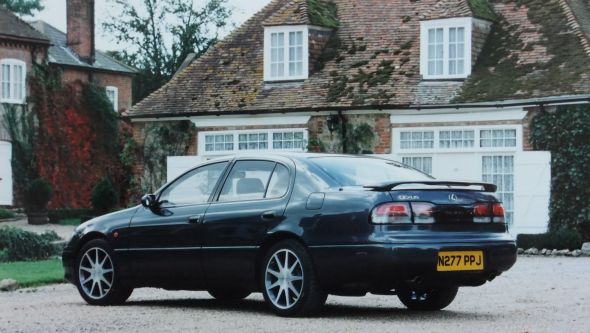
History of the Lexus GS: physical superiority
Another advantage of the luxurious new Toyota Aristo was superior on-road performance. A double wishbone chassis set-up was employed on all four corners, complementing innovations such as semi-active suspension, traction control, and a torque-sensing limited-slip differential.
All launch models were fitted with a four-speed automatic gearbox and a 3.0-litre JZ-series straight six shared with the Toyota Supra. Two versions were offered: a naturally aspirated engine with 230PS or a twin-turbocharged unit with 280PS. The latter proved especially popular in Japan as it offered outstanding acceleration within the luxury saloon car bracket. A four-wheel drive model equipped with the LS’s 4.0-litre V8 UZ-series engine was added to the domestic line-up in October 1992.
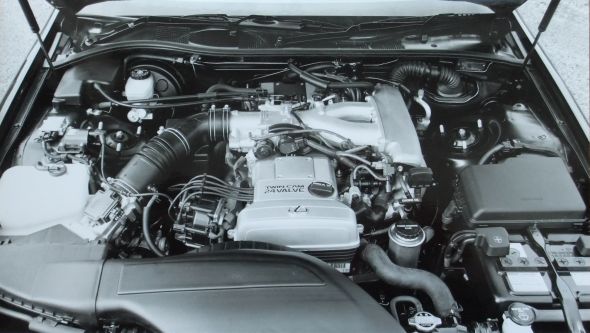
But the biggest news for the Aristo came in 1993 when it was introduced to export markets (North America, Europe and selected Asian countries) as the new Lexus GS 300. The GS initials stood for Grand Sedan and it was presented as the second most prestigious model after the flagship LS. In that respect it quickly gained a reputation as a more youthful and dynamic performance saloon, while still offering many of the luxurious qualities as the larger LS 400.
Turbocharged models were never offered outside of Japan, so the naturally aspirated 3.0-litre DOHC 24v straight six was the only engine option. Nevertheless, the GS’s tempting mix of attributes – not to mention its high quality, walnut- and leather-trimmed interior – made it a difficult package for rivals to match.
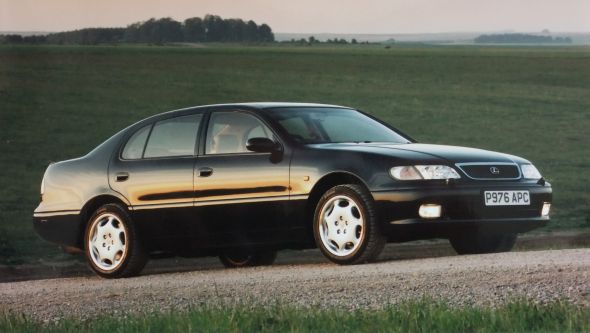
Pitched at a price point roughly equivalent to that of the LS on its 1989 launch (the LS had subsequently moved upmarket), the new Lexus GS model sold strongly, especially in its early years. But behind the scenes the development team was already busy designing its replacement.
History of the Lexus GS: shorter but larger
Released in Japan in August 1997, the second-generation Aristo inherited the aero-ellipse design theme of its predecessor, including the basic long nose, short boot proportions. Designed in-house from the outset and once again built at the Tahara Plant, the new car drew some inspiration from the first-generation Lexus SC, especially in its unique four-light front-end treatment.
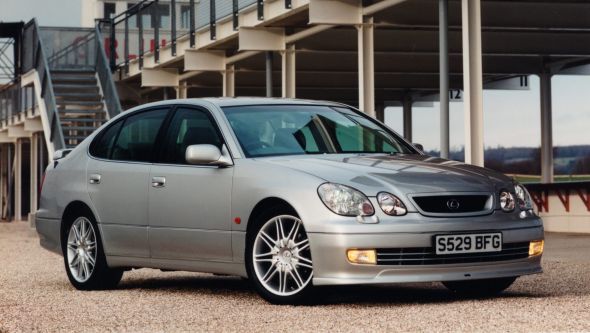
Overall, the car was 60mm shorter than before but made considerably larger inside thanks to a newly developed platform with a longer wheelbase. Luggage capacity was also improved from 404 to 515 litres. It was more slippery aerodynamically with a drag coefficient figure of Cd 0.29 (first-gen was 0.31), and the engine was moved backwards to generate a more optimised chassis balance of 53:47. This time there was no four-wheel drive option.
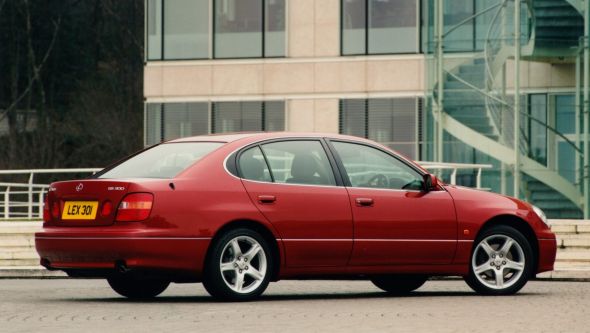
History of the Lexus GS: clearly perceived quality
Production of the export market second-generation Lexus GS began almost immediately after the Aristo’s domestic launch, in preparation for its world debut at the Frankfurt Motor Show in September 1997 and official launch later that year. On its arrival, the new GS was critically acclaimed, setting new standards of performance, safety and luxury within the executive car class. It also benefited from a more clear-cut market perception, similar to that enjoyed by its LS and IS siblings. Sales figures reflected this, with orders that were higher and more stable across its eight-year production run.
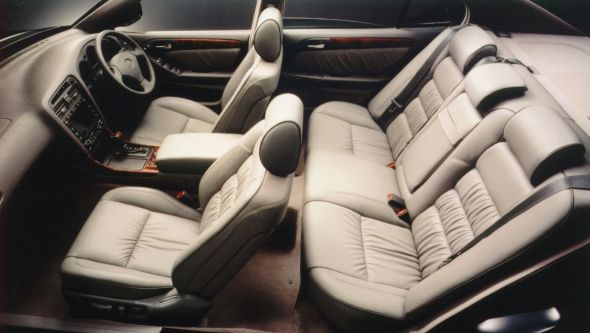
Specifications of the 3.0-litre JZ-series engines remained essentially unchanged from those of its predecessor, including the choice of naturally aspirated or twin-turbocharged versions (the turbo model was still reserved solely for Japan). However, the adoption of Toyota’s VVT-i variable valve timing technology and other improvements in the intake system enhanced the power delivery, while a new five-speed automatic gearbox for all naturally aspirated models made the most of the raised torque curve. Sophisticated torque-regulating electronic devices, including vehicle stability and traction control, were also incorporated for an unmatched arsenal of active and passive safety systems.
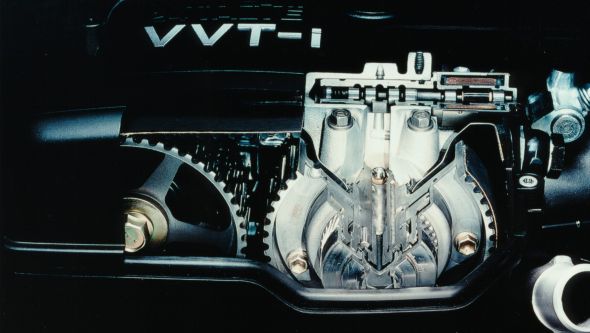
In answer to competition from increasingly muscular V8 sport saloons, the North American market was also supplied with a GS 400 model, which once again used the 4.0-litre V8 Lexus LS engine. At its launch, Lexus claimed it to be the world’s fastest production saloon and promoted it using the bold and intriguing tagline: Something Wicked This Way Comes. However, the BMW M5 launched in 1998 stole that title with faster acceleration figures.
History of the Lexus GS: brains with brawn
A subtle facelift was introduced in October 2000 for all 2001 model year cars onwards. Visual changes were few so as not to destroy the clean, original design that had been so well received. Under the skin, however, a host of alterations engineered into the chassis gave extra refinement and improved handling and braking, not to mention the headlining inclusion of a brawny new top-of-the-range model using the enlarged 280bhp 4.3-litre V8 UZ-series engine from the new LS. For the first time, this V8 derivative was also made available in Europe.
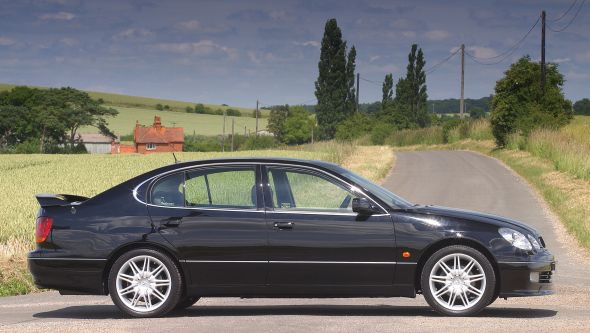
Though it shared the same powerplant, any similarities between the LS 430 and GS 430 ended there. The flagship GS was specifically developed to be more responsive and sporty, while still maintaining traditional Lexus levels of refinement.
History of the Lexus GS: worldwide alignment
Until now, the Toyota Aristo and Lexus GS had been virtually identical cars produced in parallel, destined for either domestic or export markets respectively. However, the end of production of the second-generation model coincided with an organisational separation between Toyota and Lexus that came into effect in July 2005. From this point onward, Japan aligned itself with the rest of the world, launching the Lexus brand as its premium marque and giving it a separate sales channel.
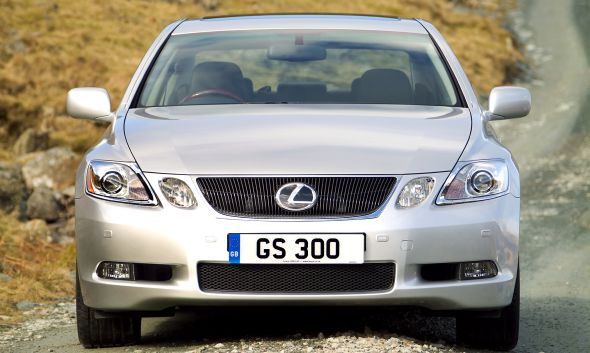
Although the Aristo line was discontinued in this switchover – as well as Toyota-branded premium models with Lexus equivalents, such as the Celsior, Altezza, Harrier and Soarer – the model effectively lived on as the new third-generation Lexus GS. Production at the Tahara Plant started in January 2005 and the car was launched in the UK in April. Due to the complexities of rolling out the changeover, Japan didn’t receive the new model until August of the same year. A little later the GS was used to spearhead the introduction of Lexus into emerging markets such as China and Russia.
History of the Lexus GS: debut of L-finesse
Based on a new longer and wider platform, this third incarnation of GS had the added distinction of being the first Lexus to debut the sleek, powerful styling of L-finesse – a bold design philosophy destined to shape a new generation of Lexus vehicles.
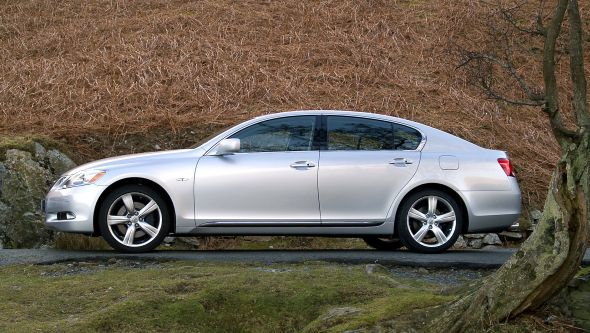
Developed over a three-year period and hinted at with the launch of the Lexus LF-S concept in 2003, this approach delivered sculptured surface treatments, with long, integrated and elegant lines. A sloping fastback shape dramatically altered the car’s profile, enhanced with blacked-out B-pillars and a sweeping belt line. But there were echoes of previous generation GSs in the quad headlights and in the ‘slingshot’ curve of the rear windows. L-finesse was more aero efficient, too, helping new GS scythe through the air with an improved drag coefficiency value of just Cd 0.27.
History of the Lexus GS: flying in V-formation
Only V-formation engines were available in the latest GS. These initially comprised new 3.0-litre and 3.5-litre GR-series V6 engines with 245bhp and 315bhp respectively, and the familiar 280bhp 4.3-litre V8 that had been used in the facelifted version of the previous generation car. All vehicles received a new electronically-controlled, close-ratio six-speed automatic gearbox, but not all markets received every engine option. Cars destined for export were primarily GS 300 and GS 430 models, while Japan opted instead for the GS 350 and GS 430. A four-wheel drive model was reintroduced to some markets, though the transmission was only paired with the V6 engines.
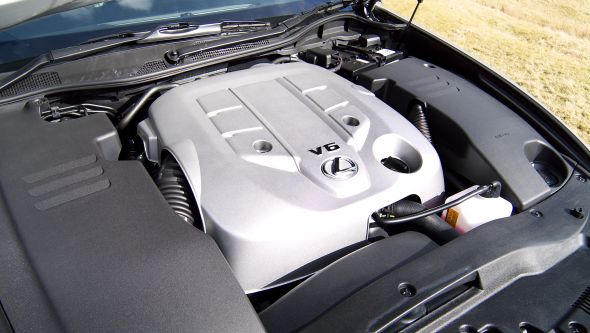
History of the Lexus GS: adding hybrid
Mild mid-cycle refreshments were carried out for 2007, 2008 and 2010 model year cars, refining the specification, handling and outward appearance. Several export markets used the first of these opportunities to delete the 3.0-litre V6 in favour of the 3.5-litre engine. Similarly, the venerable UZ-series V8 was finally exchanged for a powerful new 4.6-litre chain-driven, all-alloy UR-series V8 with variable valve timing on both intake and exhaust cams. The 342bhp GS 460 was equipped with a new eight-speed automatic transmission.
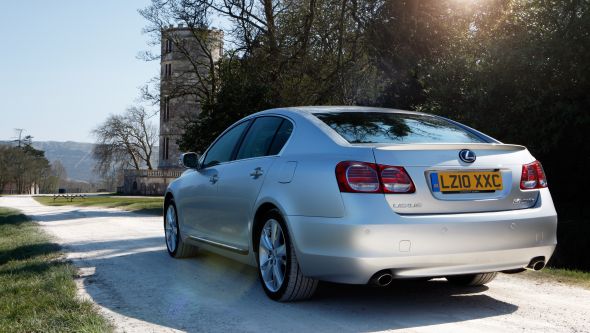
But the most important advancement for the GS came with the domestic launch of the GS 450h flagship in March 2006. This was the first hybrid saloon ever marketed by Lexus, and therefore endowed the GS with the privilege of being the world’s first mass-produced rear-wheel drive luxury hybrid vehicle.

Although the engine at the heart of the GS 450h was the same 3.5-litre V6 powering the GS 350, it was assisted by a high-output, permanent magnet electric motor that endowed the car with sportscar-like performance (0-62mph 5.7sec), combined fuel economy typical of a 2.0-litre four-cylinder saloon, and unfeasibly low emission levels. Unlike other GS models, this powerplant was paired with a continuously variable transmission (CVT). The combined output of 341bhp pitched the hybrid at a performance level similar to that of cars with 4.5-litre V8 engines, which is why this model wore the numerical designation of ‘450’.
History of the Lexus GS: embodying a re-imagined and passionate brand
The fourth-generation Lexus GS line-up was rolled out across the world through the first half of 2012, including a newly developed GS 250 entry level model, the redesigned GS 350, and second-generation GS 450h hybrid. As the centrepiece of Toyota chairman Akio Toyoda’s vision of a re-imagined and more passionate Lexus brand, it featured a uniquely progressive and sophisticated appearance. In fact, a substantial development of the latest L-finesse design philosophy first adopted in the CT 200h.
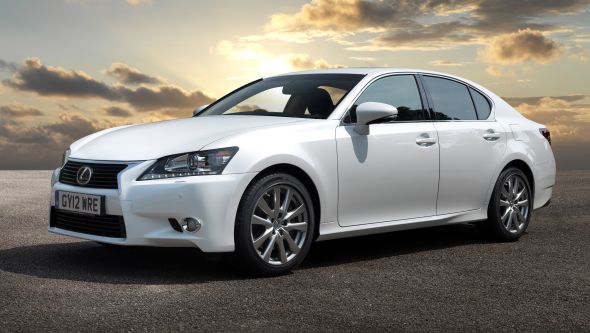
Inside, the interior design was both stylish and practical, featuring a 12.3″ wide high-resolution multimedia display (a world first in a mass-produced vehicle), the mouse-like Remote Touch interface, and a new analogue clock with LED indicators forged from a single ingot of metal.
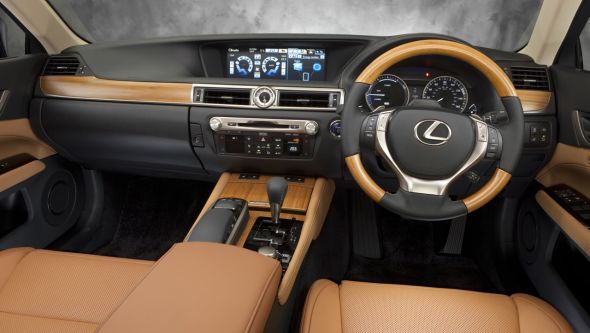
All engines were are of V6 format and came from the latest development in the GR-series range, equipped with D-4S twin fuel injection to improve engine output, fuel efficiency, and environmental performance. In addition, the GS 450h adopted a newly developed high-compression, Atkinson cycle version of the 3.5-litre engine, delivering CO2 emissions of 137g/km. This made it one of the cleanest cars within its segment, and an incredible 23% more fuel-efficient than the previous generation GS 450h. Transmission options were limited to either six-speed automatic or CVT (hybrid only), while the GS 350 was available in some markets with all-wheel drive.

In a drive to lower the car’s unsprung weight and improve handling performance, all suspension components were fabricated from aluminium. The chassis was enhanced further on F Sport models, which were equipped with the newly developed Lexus Dynamic Handling system that controlled steering angles across both axles to achieve improved steering responsiveness and deliver more stable high-speed performance.
Essentially, new GS had been designed to deliver a much more engaging and enjoyable driving experience, with sharp, responsive steering, excellent body control, high speed stability and the ride comfort expected of a Lexus performance saloon.
A mild refresh in 2015 introduced a number of new engine options, with the UK consolidating GS to a (mostly) hybrid-only line-up. The existing GS 450h powertrain was now joined by a smaller GS 300h model, which adopted the 2.5-litre four-cylinder engine and hybrid system from the IS 300h. Meanwhile, a new frontal design with bi-LED headlights created a more distinctive impression inspired by the latest round of all-new Lexus models.

The pleasing anomaly within the revised, mostly hybrid GS range was the ballistic new GS F model. It adopted the performance blueprint of the RC F, using the same atmospheric powertrain and with the handling further developed on the famously demanding Nürburgring Nordschleife. Designed to offer the best of both worlds, its 5.0-litre V8 engine and track-tuned chassis delivered thrills and excitement on challenging roads, while its practical, four-door saloon body was able to take you there and back in style and luxury.
Dwindling sales towards the end of the decade prompted Lexus to rethink its European saloon car line-up in 2018, effectively replacing the rear-wheel drive GS with the front-wheel drive Lexus ES. Total sales of the Lexus GS in the UK amounted to 21,894 units.
All information is correct at the time of publishing.
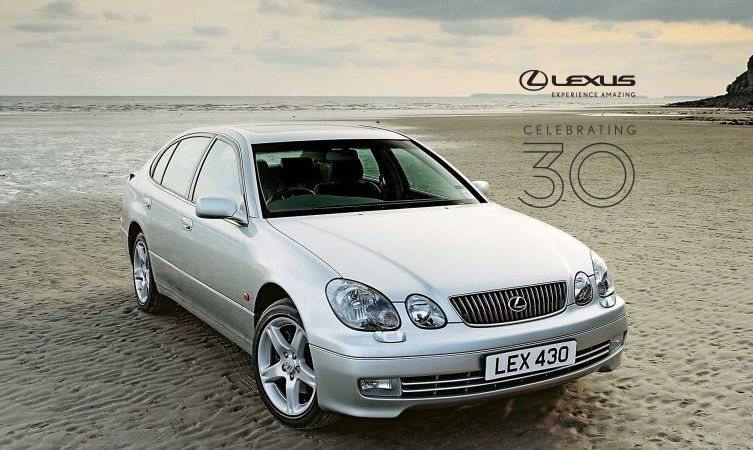




My 2007 is a fantastic, no trouble vehicle, good build, very responsive both driving and power. Great engineering and very pleasant interior with all I need. Yes ,and great paint finish.
Appreciate the blog with a very honest take, nodding to performance figures the M5 achieved or to the reality of dwindling sales in 2018. A small history lesson, crisp and honest, just like the GS was 🙂
Hi Avinash,
Thanks for getting in touch. We’re glad to hear you’re a fan of the GS. We have plenty of other history blogs about our range that you might enjoy. You can find out more about the history of the ES, which did ultimately replace the GS in our UK line-up, here: https://mag.lexus.co.uk/lexus-es-history/
Thanks.
Since 1999 I saved miney and m9nitored when an Aristo turbo vvti would be mine. In 2009 I came close and was frustrated by a reluctant seller. and ended up buying a new Hilux Vigo. Understsnc hete they Aristos are used JDM imports. And Toyota here is limited in range. Anyway I got my JZS161 in 2018 . And what a different level of refinement 8t is. Espevially compared to the big name Germans who seem to now make disposible cars. Look at the Direct injection fiasco. Great for efficiency but YLexus Toyota first to dual inject.
Since I’ve purchased my first Lexus in mid 1995 it was the 1992 Lexus SC 400 coupe and from that point on I never drove any other car but Lexus current today this is now my seventh Lexus and I am an owner of a 2013 Lexus GS 350 all-wheel-drive and I can tell you less it is the absolute best car for the money I love it with a passion and I love Lexus they are so reliable Sexy classy fast everything that Lexus says they stand up to the test of time
Hello Salvatore,
Thank you for your kind words.
We wish you many more luxurious miles in your GS 350.
Thanks.
I still have a MK1 GS Sport.
Love it.
Thank you for your kind words, Jon.
We wish you many more luxurious miles.
Thanks.